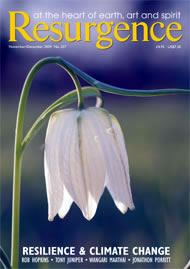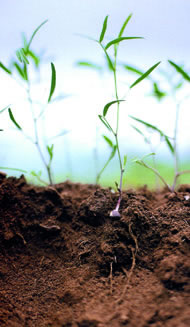Putting the many approaches to agriculture into simplistic categories and making sweeping generalisations about their merits and faults has led to farmers of all kinds feeling that their methods are unfairly criticised. There are farmers employing good techniques in every category. As well as working harder than many other professions, for low remuneration, most farmers care about their work and want to provide the best products and maintain their livelihoods for the future. However, pressures including competition, prices, perceived need for high productivity, sector policy and marketing of agricultural inputs have led to many farm practices that ‘borrow’ more carbon from the soil each year than they put back.
There is a newly emerging way of looking at farming that recognises good techniques being practised on any type of farm. It gives credit where due and creates a level playing field for assessing all approaches to farming: traditional, mechanised, intensive, organic, biodynamic or permaculture. This universal aspect of good farming could perhaps be called ‘rich-soil farming’.
The three major considerations in the assessment of food production are the quality and quantity of food produced and the ability to continue production. At a biological level, it is soil that produces food, and its production capacity can be enhanced or reduced. Typical rich forest soil might be made up of approximately 15% air, 15% water, 60% rock and minerals and 10% organic matter. Organic matter is decomposed plant matter (humus) and animal life in the form of microbes and insects, and is at least 50% carbon. As the rock content of soil is stable, and air and water content are affected by organic matter, the critical controllable factor that determines food quality, quantity and continued productivity is increasing or decreasing its organic matter content.
Over 70% of Britain is covered with agricultural land, so the greater part of the soil and plant life of this island is controlled by human management. The soils of natural oak forests in the UK contain around 10% organic matter but in the majority of British agricultural land this has been reduced to an average of 3.5% and in some intensively farmed arable land to just 1%. But the good news is that while some farming practices decrease soil organic matter, others increase it, and a host of recent studies are helping to define the effectiveness of different practices.
In my role as designer of the Resurgence Carbon Calculator and a promoter of low-carbon lifestyles, I was recently approached by Jonathan Smith of Climate Friendly Food (CFF), an organisation dedicated to reducing the climate impact of food and farming. Jonathan asked me to work on the development of a new carbon calculator for farmers and growers, that takes into account the sequestration processes in soil and plant life. He envisaged that the farmers’ and growers’ carbon calculator would form the basis of the world’s first low-carbon food certification programme, enabling food producers to calculate and label the climate impact of their produce and allowing consumers to choose products that help mitigate the effects of food production on the climate. What neither of us expected was that the carbon calculator unveiled a previously underestimated benefit of rich-soil farming: that it sequesters atmospheric carbon dioxide at an incredible rate.
Micro-organisms and organic matter in healthy soils ‘store’ carbon, and initial research suggests that farmland may have the potential to sequester as much CO2 per hectare as a forest. But not all farmland is healthy: much of it over the years has been denatured by industrialised agricultural practices. Plants form a ‘carbon highway’ from atmosphere to soil, and this process of turning air into soil has four stages: the first is photosynthesis, whereby plant leaves use the sun’s energy to absorb carbon dioxide and separate the carbon and oxygen to form sugars; secondly, resynthesis occurs inside the plant, where the sugars are transformed into more stable carbon compounds; thirdly, exudation and the release of organic matter happen when plants exude carbon into the soil through their roots, and when leaf, stem and root matter enters the soil through the natural lifecycle process; and fourthly, humification takes place when soil microbes decompose plant carbon into a more stable form (humus).
All farmland employs the first three stages, but much intensive agriculture fails to maintain the fourth stage, the soil microbial life. It is the microbes that make the humus, storing carbon in the soil and preventing it from re-oxidising to the atmosphere. Humus also provides nutrition to plants and, like a sponge, holds on to the water content of the soil.
Rich-soil farming increases soil organic matter and microbial life by maintaining a balance between the organic matter removed from the land as crops and that returned to the land as compost or manure. Nitrogen-fixing crops are used to fertilise the land and support soil life, and their high growth rates rapidly sequester carbon. Natural pest controls avoid poisoning microbes and promote insect and animal diversity, in turn sequestering more carbon dioxide because the very bodies of Earth’s life forms are made of carbon. Maintaining soil cover and adopting minimal tillage avoids the oxidisation of carbon from the soil and keeps microbes alive with a constant supply of food from plant roots.
The prototype growers’ carbon calculator showed that even on a small scale a farm employing rich-soil practices can sequester so much carbon that even if the farmer uses diesel tractors and four-wheel drive vehicles and engages in other fuel-intensive activities, soil sequestration will still make it a net carbon sink.
Further calculations suggest that on a global scale, rich-soil farming could have a sequestration potential so powerful that it could turn back the carbon clock. These figures are backed up by the latest science. A 2007 study for the Intergovernmental Panel on Climate Change estimates that if world agriculture adopted best practices to increase soil organic matter content, it could mitigate 6 to 10 billion tonnes of carbon dioxide equivalent per year by 2030, which is between 20% and 35% of current annual global emissions (29 billion tonnes per year). As the world has approximately 5 billion hectares of agricultural land, this equates to a sequestration rate of between one and two tonnes of carbon dioxide per hectare, which, considering the growth rates of many plants, could be conservative. For example, recent research has found that forests can absorb over 8 tonnes of carbon dioxide per hectare every year for hundreds of years, and if very best practices were adopted, rich-soil farming could potentially match this. To quantify the sequestration potential of best farm practices, CFF is building a database of soil samples and changes in organic matter content from year to year.
To mitigate 100% of current global emissions, the world’s agricultural land would need to sequester an average of 6 tonnes of CO2 per hectare per year, and research so far shows that some systems can achieve this. Anything above that level would begin to turn back the carbon clock, bringing down atmospheric carbon dioxide levels to that of consecutive previous years. CFF believes that rich-soil farming can produce quality food for a growing world population whilst enhancing biodiversity, food security and healthy ecosystems, and at the same time mitigate significant amounts of global carbon dioxide.
At the time of writing (August 2009), the prototype growers’ carbon calculator is being field-tested and further research is being conducted. The calculator will undoubtedly need to be further calibrated and fine-tuned. But what is not in doubt is that rich-soil farming – indeed, gardening too – has an enormous and growing part to play in addressing climate change.
Climate Friendly Food launches the carbon calculator for organic growers in October 2009 (non-organic version launching 2010), together with the world’s first low-carbon food certification programme. For more information visit www.climatefriendlyfood.org.uk With thanks to Jonathan Smith for his important contribution to this article.








